

Semantic MediaWiki – Meta. Semantic MediaWiki has moved!
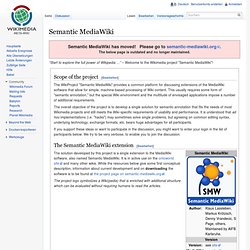
Please go to semantic-mediawiki.org. The below page is outdated and no longer maintained. “Start to explore the full power of Wikipedia …” – Welcome to the Wikimedia project "Semantic MediaWiki"! See also[Bearbeiten] Related extensions[Bearbeiten] The Halo Extension facilitates the use of Semantic Mediawiki for large communities of non-tech-savvy users Similar extensions[Bearbeiten] User:HeikoIdensen - Semantic Community Wiki. Semantic wiki. A semantic wiki is a wiki that has an underlying model of the knowledge described in its pages.
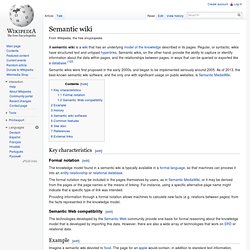
Regular, or syntactic, wikis have structured text and untyped hyperlinks. Semantic wikis, on the other hand, provide the ability to capture or identify information about the data within pages, and the relationships between pages, in ways that can be queried or exported like a database.[1][2] Semantic wikis were first proposed in the early 2000s, and began to be implemented seriously around 2005. As of 2013, the best-known semantic wiki software, and the only one with significant usage on public websites, is Semantic MediaWiki. Key characteristics[edit] Formal notation[edit] The knowledge model found in a semantic wiki is typically available in a formal language, so that machines can process it into an entity-relationship or relational database.
Semantic Web compatibility[edit] Example[edit] History[edit] In July 2010, Google purchased Metaweb, the company behind Freebase.[8] Common features[edit] Enterprise - for professional blogs and media. How Zemanta Avoided Fraudulent 301 Media Traffic Three years ago (in November 2014) our anti-fraud efforts at Zemanta flagged a set of sites with statistics that were too good to be true — lots of pageviews, lots of clicks, and low CPC.
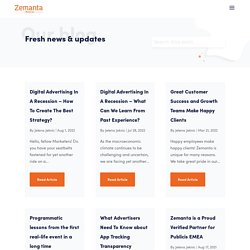
But those same sites also had low engagement after the click and virtually no... read more Zemanta is Outbrain’s only official DSP partner As our CTO in charge of supply, Andraz put it: “We’ve been one of the first to utilize Outbrain API and it is great to see Outbrain creating a whole ecosystem around it. Read more Tapping Into Native Inventory from Google’s AdX. Was bedeutet Semantic Tagging? Blogging Semantic, all the news, insights and thinking from Semantic. The People’s Google « Evolving Trends. Author: Marc Fawzi Twitter: License: Attribution-NonCommercial-ShareAlike 3.0 This is a follow-up to the Wikipedia 3.0 article.
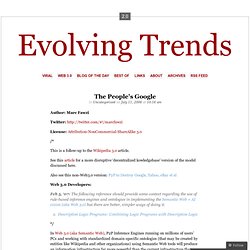
See this article for a more disruptive ‘decentralized kowledgebase’ version of the model discussed here. Also see this non-Web3.0 version: P2P to Destroy Google, Yahoo, eBay et al Web 3.0 Developers: Feb 5, ‘07: The following reference should provide some context regarding the use of rule-based inference engines and ontologies in implementing the Semantic Web + AI vision (aka Web 3.0) but there are better, simpler ways of doing it.Description Logic Programs: Combining Logic Programs with Description Logic Having the sandardized ontologies and the P2P Semantic Web Inference Engines that work with those ontologies will lead to a more intelligent, “Massively P2P” version of Google. Therefore, the emergence in Web 3.0 of said P2P Inference Engines combined with standardized domain-specific ontologies will present a major threat to the central “search” engine model.
Addendum. ATLAS.ti - The Knowledge Workbench. ATLAS.ti ist ein leistungsfähiges analytisches Werkzeug.
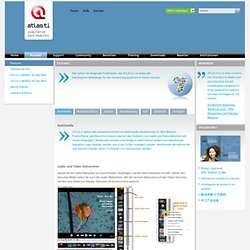
Seine individuellen Auswertungsmöglichkeiten sind zentral organisiert und für maximale Effizienz, Genauigkeit und Leistung ausgelegt. Cloud Views bieten sehr schnellen, genauen und dennoch intuitiven analytischen Zugriff auf Ihr Datenmaterial. Das Query-Tool, der Cooccurence Explorer und die Codes-PD-Tabelle ermöglichen eingehende und umfassende Analysen. Der Schwerpunkt des Query-Tools und des Cooccurence-Baum-Explorers liegen auf qualitativen Ergenissen; die anderen Werkzeuge liefern quantitative Informationen, die sich als Verweise auf die qualitativen Daten dahinter nutzen lassen. Cloud Views für Codes und Dokumente Die Code-Liste kann in Form von verschiedenen Cloud-Ansichten angezeigt werden. Code cloud view Die Document Cloud lässt sich über die gesamte Textbank oder für einzelne Dokumente getrennt erstellen.
Word Coud - Vergleich von vier Zeitungsartikeln.